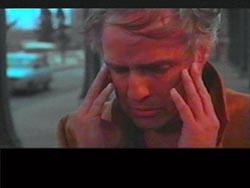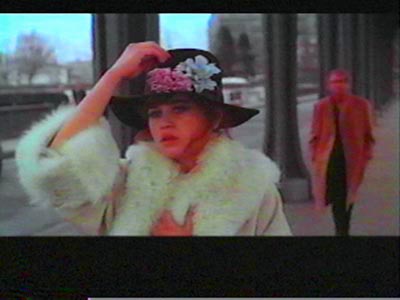Last Tango In Paris

|
|
|
Bacon is best known for his tortured figures that evoke feelings of existential despair, and this is the dominant mood of Last Tango as well. Bertolucci connects the worlds of Bacon and Last Tango from the very outset of the film when the two images you see above by Bacon lead directly from the credit sequence into the opening shot of the film. Let's look at that transition. It's a masterful shot, and with its moving camera it helps us feel the mood of this film as a kind of dance, one of exquisite beauty but also of great despair. |
|
| Scroll your mouse over the three images of Paul (played by Brando) to reveal the images beneath them. They are from the bathroom where Paul's wife Rose had slit her wrists, and suggest that what is behind Paul's despondent condition is Rose's suicide. The woman shown in them is cleaning the blood out of the bathtub, and has been filmed through textured glass such that her face is distorted in a way that recalls Bacon's faces. |
| Below, using the buttons, you can compare stills from Last Tango with some of Bacon's paintings. Look for correspondences along the lines of 1) Color (Bertolucci once called Last Tango an "orange" film); 2) Theme or subject matter: both artists, for example, seem fascinated by the the human body's potential for decay and distortion; 3) Composition: The structure of the apartment that forms the central set of Last Tango, with its lines around the baseboard of the wall and its almost circular quality, evokes Bacon's compositional technique of dividing his canvases horizontally with an arc. Also, the contorted postures and gestures of characters in Last Tango often allud e to Bacon's ways of rendering figures compositionally in his paintings. |

|
|
|
Look back at the second of the three Brando images above. In the background you can see Jeanne, the woman with whom Brando's character tries in a three-day affair, to assuage, the grief he feels because of his wife's inexplicable suicide. This is another wonderfully-orchestrated shot using a moving camera. The girl passes by and looks at him, but he doesn't notice her. They will pass each other again in the apartment building bathroom before meeting by chance upstairs. Here is a better shot of the girl, played by Maria Schneider, toward the end of the clip you just saw:
|
|
 o many, Last
Tango in Paris is one of the great explorations of cinema's visual
possibilities. Director Bernardo Bertolucci, like his Italian compatriot
Antonioni, a relationship between his role and that of a painter.
In fact, Bertolucci went so far as to base Last Tango on the
work of Francis Bacon, widely regarded as one of the greatest painters
of the 20th century. While they were in Paris ready to begin shooting
of the film, Bertolucci and Marlon Brando, the film's star, saw a
show of Bacon's images. It made such an impression on them that it
changed their entire conception of how the film would work.
o many, Last
Tango in Paris is one of the great explorations of cinema's visual
possibilities. Director Bernardo Bertolucci, like his Italian compatriot
Antonioni, a relationship between his role and that of a painter.
In fact, Bertolucci went so far as to base Last Tango on the
work of Francis Bacon, widely regarded as one of the greatest painters
of the 20th century. While they were in Paris ready to begin shooting
of the film, Bertolucci and Marlon Brando, the film's star, saw a
show of Bacon's images. It made such an impression on them that it
changed their entire conception of how the film would work.



